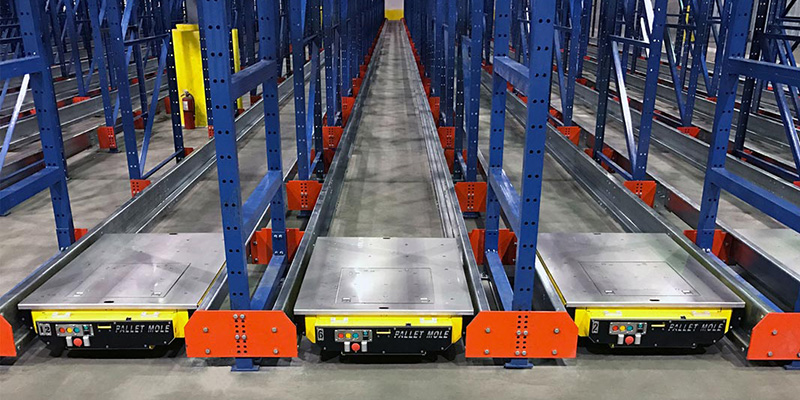If you're searching for ways to increase storage capacity, you'll likely run across two standout options: Pallet Mole and ActivRAC. They don't look alike, and they definitely don't work the same way, but they both solve the same core challenge: how to get more out of your footprint.
That said, each one takes a very different approach to space, access, and throughput. And if you pick the wrong fit for your workflow, you could end up with a system that shows your team down or eats up valuable square footage.
This side-by-side guide breaks down how both systems operate, where each one shines, and how to make the right call whether you're optimizing a legacy layout or designing a warehouse from scratch.
Consider Inventory Access Needs
Before diving into the details, start with a simple question: How often do you need to access your inventory?
That one answer can tell you a lot. If you're storing high-turnover goods, your priorities and your high-density racking system will look very different than if you're dealing with low-access or long-term storage.

Pallet Mole and ActivRAC both excel at maximizing storage density, but they're built for different workflows. That's why your access needs, your layout, and your throughput all matter when choosing the right fit.
High-Density Storage Racking Snapshots
Pallet Mole and ActivRAC are both high-density storage racking systems...but that's about where the similarities end. Each one is built for a different kind of operation, and knowing the difference can make a big impact on your space and workflow.
Here's a broad look at how they stack up:
- Pallet Mole is a semi-automated, radio frequency-controlled platform that shuttles pallets in and out of deep-lane racking. It's ideal for LIFO or FIFO storage setups where access is limited and throughput is high.
- ActivRAC is a rail-based mobile racking system that eliminates static aisles. It's designed for dense storage that still needs to stay accessible, especially in environments with a wide mix of SKUs.

Of course, if you're weighing these options for a major investment, you'll want more than a surface-level comparison. Let's dig into where each one really shines.
Digging into the Comparison
This section breaks down the most common questions we hear from industrial clients, things like:
- Storage density
- Inventory Access
- Throughput
- Control
You'll see exactly where each system works best, and which one fits best based on your layout, workflow, and inventory needs.
Storage Density
Both Pallet Mole and ActivRAC are built for high-density storage, but the way they do it couldn't be more different:
Pallet Mole uses deep-lane storage, stacking pallets up to 50 deep and 6 high. That makes it a great option for maximizing floor-to-ceiling and front-to-back density in high-volume, low-SKU environments like freezer facilities, beverage distribution, and food processing. It's a great fit when you want to save space and keep throughput moving.

ActivRAC, on the other hand, is designed to double your storage capacity by eliminating static aisles. Racks move laterally on rails and open only when needed, helping you reclaim space without sacrificing access. It's a strong choice for operations with heavier pallets, mixed SKUs, and constantly shifting workflows, especially when expansion isn't an option.
Inventory Accessibility
If there's one factor that shapes your choice, it's this: How often, and how quickly, do you need to access your inventory?
Pallet Mole is built for the predictable movement of large batch SKUs. It works best in LIFO or FIFO setups and uses radio frequency. For operations with scheduled truck turns and consistent workflows, it delivers both speed and efficiency, and can give users as much as 40% cost savings.
ActivRAC is better suited for environments with mixed or high-variety inventory. Each aisle can be opened on demand, making it easier for teams to pick what they need without waiting or wasting space. Systems come in mechanical-assist or powered configurations to match both light and heavy-duty use.

Throughput Efficiency
Throughput matters, especially when you're trying to keep costs down and bottlenecks out of the picture. The right high-density racking system can improve how quickly and consistently your team loads, unloads, and restocks inventory. The question is, how fast do you need to move?
Pallet Mole shines in environments where speed and volume are top priorities. Its electromechanical shuttles can lift, lower, and deliver up to 50 pallets per hour, enough to load a trailer in under 30 minutes.
ActivRAC holds its own when it comes to picking efficiency. Powered and mechanical-assist racks keep retrieval moving, even under heavy loads. But for high-speed lane loading and repetitive movement, Pallet Mole takes the edge.
Automation & Controls
Smart controls keep your team moving safely and consistently (in addition to speeding things up, of course).
PalletMole offers semi-automation that's hard to beat. Operators can control shuttles via handheld remote or Wi-Fi, set the system to run automatically, or call a shuttle to the aisle they need. That means fewer steps, fewer forklifts in motion, and fewer chances for injury.
ActivRAC, on the other hand, puts control in the user's hands. Open aisles with a handle, push-button, or RF remote. Workers on foot walk less, and drivers can stay on their forklifts, keeping material flow steady.

If you're looking for automation that boosts speed and minimizes manual input, Pallet Mole takes the lead. But for intuitive, on-the-floor control in a fixed footprint, ActivRAC holds its own.
Best Fit Environments
Your space says a lot about which system makes sense. So does what you're storing, how often you're touching it, and how flexible your layout needs to be.
Pallet Mole thrives in deep line environments that move large quantities of the same SKU. Think cold storage, freezer facilities, beverage and food processing, and 3PL shipping lanes, places where storage density and throughput matter more than access variety.
ActivRAC is built for flexibility. It adapts to irregular layouts, columns, or shifting zones. You'll often find it in tool cribs, packing stations, and under-mezzanine installs for general warehouse storage. It's a go-to for manufacturers, pharma, and operations juggling heavy loads and mixed inventory.
Decisions, Decisions
Still weighing your options? When it comes to high-density storage racking, there's no wrong answer, just a better fit for your space and processes. The following tips can help you decide based on your specific needs.

Choose Palllet Mole if:
- You need deep-lane, high-density storage for large quantities of the same SKU
- Access is infrequent but consistent (think scheduled truck turns or batch moves)
- You prioritize loading/unloading and throughput
- You're working in cold storage, freezer, or temperature-controlled environments

Choose ActivRAC if:
- You need 100% SKU access without giving up storage density
- You want to double your storage capacity in the same footprint
- Your inventory is mixed, dynamic, or constantly changing
- Your space includes columns or odd layouts that require flexible, adaptable storage
What We Tell Clients
We've worked with a lot of industrial teams. And nearly every time, we hear the same three questions:
- Can we still get to everything?
- How dense can we go?
- What happens when our process changes?
Truth is, choosing the right high-density racking system can feel like a big lift. But you don't have to figure it out on your own. Our consultants have been solving storage puzzles for decades, and we're here to help you make the call that fits your space, flow, and team.
Still unsure whether Pallet Mole or ActivRAC is the right fit? Let's take a walk through your current setup. We'll break it down, tape measure in hand, with no pressure and real guidance.


















